هراقليس
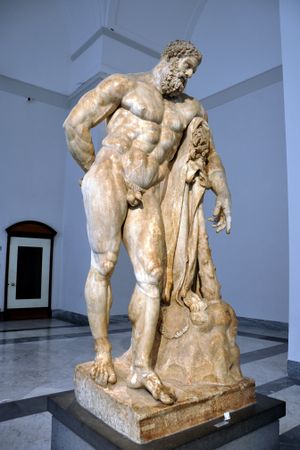
| الأساطير اليونانية |
|---|
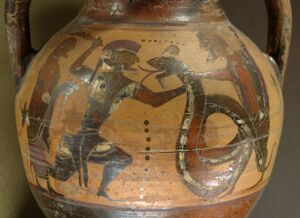 |
| الآلهة |
| الأبطال والبطولات |
| متعلقات |
Heracles (تــُنطـَق /ˈhɛrəkliːz/ HERR-ə-kleez; باليونانية: Ἡρακλῆς, Hēraklēs, from Hēra, "Hera", and kleos, "glory"[1]), born Alcaeus[2] (Ἀλκαῖος, Alkaios) or Alcides[3] (Αλκείδης, Alkeidēs), was a divine hero in Greek mythology, the son of Zeus (Ζεύς) and Alcmene, foster son of Amphitryon[4] and great-grandson (and half-brother) of Perseus (Περσεύς). He was the greatest of the Greek heroes, a paragon of masculinity, the ancestor of royal clans who claimed to be Heracleidae (Ἡρακλεῖδαι) and a champion of the Olympian order against chthonic monsters. In Rome and the modern West, he is known as Hercules, with whom the later Roman Emperors, in particular Commodus and Maximian, often identified themselves. The Romans adopted the Greek version of his life and works essentially unchanged, but added anecdotal detail of their own, some of it linking the hero with the geography of the Central Mediterranean. Details of his cult were adapted to Rome as well.
ولد هرقل في طيبة. وكان ابن الأميرة ألكمين، وزيوس، ملك الآلهة كما تزعم الأسطورة. وكانت هيرا، زوجة زيوس غيورة من إلكمين وكرهت هرقل. وقد اضطهدت هرقل طوال حياته.
وعندما كان هرقل طفلاً، أرسلت هيرا من يقتله. إلا أن هرقل فطن لهذا. وكان هرقل شاباً واسع الخيال وكان أمام خيارين؛ إما الحياة السهلة والسرور، أو حياة صعبة وخطرة ونصر، وفضيلة. وقد اختار الحياة الأكثر صعوبة ـ لكنها فاضلة. كلف بالقيام باثنتي عشرة مهمة خارقة فأنجزها وأصبح حرًا طليقًا. وزعموا أنه صعد بعد موته إلى جبل الاوليمپس وأصبح إلهًا. [5]
Cult
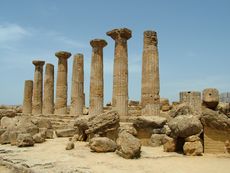
The ancient Greeks celebrated the festival of the Herakleia, which commemorated the death of Heracles, on the second day of the month of Metageitnion (which would fall in late July or early August). What is believed to be an Egyptian Temple of Heracles in the Bahariya Oasis dates to 21 BC.
Myths
Birth and childhood
Youth
Labours of Heracles
Not all writers gave the labors in the same order. Apollodorus (2.5.1-2.5.12) gives the following order:
- To kill the Nemean lion.
- To destroy the Lernaean Hydra.
- To capture the Ceryneian Hind.
- To capture the Erymanthian Boar.
- To clean the Augean Stables.
- To kill the Stymphalian Birds.
- To capture the Cretan Bull.
- To round up the Mares of Diomedes.
- To steal the Girdle of Hippolyte.
- To herd the Cattle of Geryon.
- To fetch the Apples of Hesperides.
- To capture Cerberus.
Other adventures
Women

عشاقه الرجال
Children
Telephus is the son of Heracles and Auge.
Death
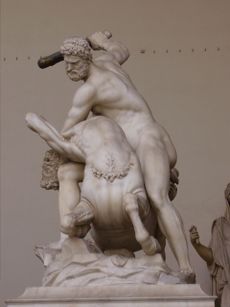
في روما
 مقالة مفصلة: هرقل (نصف إله)
مقالة مفصلة: هرقل (نصف إله)
هراقليس في الثقافات الأخرى
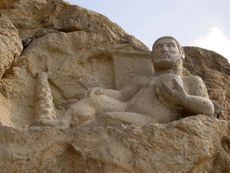
Via the Greco-Buddhist culture, Heraclean symbolism was transmitted to the far east. An example remains to this day in the Nio guardian deities in front of Japanese Buddhist temples. Herodotus connected Heracles both to Phoenician god Melqart and to the Egyptian god Shu. Temples dedicated to Heracles abounded all along the Mediterranean coastal countries. For example the temple of Heracles Monoikos (i.e. the lone dweller), built far from any nearby town upon a promontory in what is now the Côte d'Azur, gave its name to the area's more recent name, Monaco.
The gateway to the Mediterranean Sea from the Atlantic ocean, where the southernmost tip of Spain and the northernmost of Morocco face each other, is, classically speaking, referred to as the Pillars of Hercules/Heracles, owing to the story that he set up two massive spires of stone to stabilise the area and ensure the safety of ships sailing between the two landmasses.
Organisations named after Heracles include the Greek football team Iraklis F.C..
Heracles was canonized by Aleister Crowley as a saint in Ecclesia Gnostica Catholica.
الحسب[6]
| زيوس | دنائ | ||||||||||||||||||||||||||||||||||||||||||||||||||||||||||||||||||||||||||||
| پرسيوس | أندرومدا | ||||||||||||||||||||||||||||||||||||||||||||||||||||||||||||||||||||||||||||
| Perses | Alcaeus | Hipponome | Electryon | Anaxo | Sthenelus | Menippe | Mestor | ||||||||||||||||||||||||||||||||||||||||||||||||||||||||||||||||||||||
| Anaxo | أمفيتريون | ألكمنه | زيوس | Licymnius | اوريثسيوس | ||||||||||||||||||||||||||||||||||||||||||||||||||||||||||||||||||||||||
| إفيكلس | مگارا | Heracles | ديانيرا | هبه | |||||||||||||||||||||||||||||||||||||||||||||||||||||||||||||||||||||||||
| ايولاوس | Three Children | Hyllus | Macaria | Others | |||||||||||||||||||||||||||||||||||||||||||||||||||||||||||||||||||||||||
انظر أيضاً
Other figures in Greek mythology punished by the gods include:
الهامش
- ^ Becking, Bob, et al.. Dictionary of deities and demons. ed. Toorn,Karel van der. Wm. B. Eerdmans Publishing. 1999
- ^ Schmitz, Leonhard (1867). "Alceides". In William Smith (ed.). Dictionary of Greek and Roman Biography and Mythology. Vol. 1. Boston: Little, Brown and Company. p. 98.
- ^ Apollodorus, ii. 4. § 12
- ^ (Ἀμφιτρύων). By his adoptive descent through Ampitryon, Heracles receives the epithet Alcides, as "of the line of Alcaeus", father of Amphitryon. Amphitryon's own, mortal son was Iphicles.
- ^ "هرقل". الموسوعة المعرفية الشاملة.
- ^ Morford, M.P.O, Lenardon R.J.(2007)Classical Mythology. pp. 865 Oxford: Oxford University Press.
المصادر المعاصرة
- Kerenyi, Karl (1959). The Heroes of the Greeks. New York/London: Thames and Hudson.
الهامش
- Heracles at Theoi.com Classical literature and art
- Timeless Myths - Heracles The life and adventure of Heracles, including his twelve labours.
- Heracles, Greek Mythology Link
- Heracles (in French)
- Vollmer: Herkules (1836, in German)
- Burkert, Walter, (1977) 1985. Greek Religion (Harvard University Press).
للاستزادة
- Padilla, Mark W. (1998). "Herakles and Animals in the Origins of Comedy and Satyr Drama". In Le Bestiaire d'Héraclès: IIIe Rencontre héracléenne, edited by Corinne Bonnet, Colette Jourdain-Annequin, and Vinciane Pirenne-Delforge, 217-30. Kernos Suppl. 7. Liège: Centre International d'Etude de la Religion Grecque Antique.
- Padilla, Mark W. (1998). "The Myths of Herakles in Ancient Greece: Survey and Profile". Lanham, Maryland: University Press of America.
وصلات خارجية
 Media related to هراقليس at Wikimedia Commons
Media related to هراقليس at Wikimedia Commons
- صفحات بالمعرفة فيها قوالب حماية خاطئة
- Semi-protected
- Portal-inline template with redlinked portals
- Pages with empty portal template
- Articles containing Greek-language text
- Articles with hatnote templates targeting a nonexistent page
- Heracles
- Argonauts
- Demigods of Classical mythology
- آلهة يونانية
- أساطير يونانية
- عبادة الأبطال الأسطوريين اليونانيين
- Monomyths
- أعمال هرقل
- أنجال زيوس
- Oracular gods
- آلهة مخلصة
- Greek culture heroes
- Heroes who ventured to Hades






